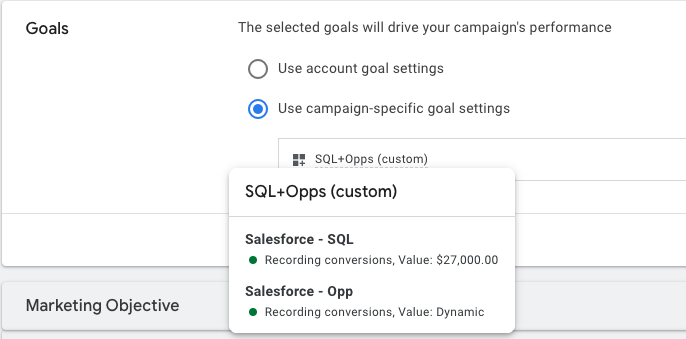There are many use cases and types of businesses that benefit from setting up offline conversion tracking in Google Ads. This is especially true for B2B marketers, and it should be a top priority as it can make all the difference in measuring and optimizing performance. It lets you share data with your automated bidding strategies that you were previously missing out on and optimize towards those actions.
Setup is only the first step, of course. If you've implemented offline conversion tracking and are not entirely sure where to go from here, read these tips for optimizing your campaigns for the best lead quality.

Capture & Pass through GCLID Values
First, ensure your GCLID (Google Click ID) values are captured and passed to your CRM. The GCLID is created automatically by Google when a user clicks on an ad. It is the key to connecting offline conversions to their related campaigns within a Google Ads account. If you don't have GCLID info in your CRM data, you will still be in the dark about which campaigns and keywords are driving your conversions, even if offline conversions are set up.
To capture the GCLID in your CRM, it will need to be passed through the form submission when a prospect submits a lead. You will need to:
- Add a hidden field to your lead form or a script to your web pages to capture and store the GCLID.
- Store the GCLID with the prospect's information in your CRM. This may require you to create a new column in your CRM labeled GCLID (example below).

Ensure the Right Conversion Data Is Passing Through
If you've set up your Google ads offline conversions to pass through automatically using Zapier, HubSpot, or another tool, make sure your conversion data is actually passing through and that the information is correct. There’s nothing worse than recording conversions for the wrong action and using that to influence your campaign performance or going months and not realizing the data isn’t passing through.
One of the easiest ways to test this is to regularly look at the different stages (or conversion actions) in your CRM and check to see if they reflect what is showing in Google ads for those same conversion actions. If they do, that's awesome, but if they don't, you may want to check the time period you are looking at or attribution settings and see how they compare to your CRM attribution settings, e.g. first click, last click, last touch, etc.
Set Values for Your Conversion Actions
Assigning values to each conversion action is an important optimization to leverage and is helpful in many ways:
- It helps Google better understand the impact each action has on your business.
- It allows you track, optimize, and report on your return on ad spend (ROAS).
- It lets you identify which keywords are driving valuable conversions down the funnel or which keywords are not so valuable.
- Ultimately it helps you go beyond conversion volume and use ROI data to make better and more informed decisions for your business.
You can select static values for each action or dynamic values that pull from your CRM data. As much as possible you should try to set the values as accurately as possible. For example, if it’s a purchase conversion that could have varying amounts, dynamically pulling in the order value is best. If you use static options, you can use the average value of each stage, like $500 for purchase and $100 for a lead. If you don’t know these numbers, it’s best practice to set different values for each action to help Google understand the impact each has on your business and which are more valuable.
These conversions represent your lead-to-sale journey. They should represent all of the events that gradually process and qualify inbound leads into a paying customer, so start by thinking of the lifetime value of your customer when determining values.
Optimize Towards Your Offline Conversion Actions
Now that you've confirmed the GCLID is captured and passing through properly, and you’ve assigned values to your conversion actions, it's time to put your offline conversions to work.
Below are two methods of testing:
1. Optimize Towards One Conversion Action vs. Multiple
Since you now have offline conversions set up, test adding those to your campaign optimization goals. The more down-funnel data you can feed your campaigns, the more you can help Google find your ideal customer. For example: if you were previously optimizing towards leads, and now, with offline conversions, you have sales qualified leads (SQLs) in the account as well, try using custom goals to optimize campaigns towards SQLs+Opps or just SQLs.
Here’s what that might look like in Google:



Note: Be mindful of the amount of data your offline conversions receive. Google recommends 30-50 conversions in the last 30 days. If you don’t have enough conversions coming through for an action you’re optimizing towards, your campaign performance could drop.
2. Automated Bid Strategies
Automated bidding takes the guesswork out of setting bids and allows you to enter the auction strategically. Pairing this with your offline conversion data will help you enter auctions and bid when you're more likely to get that offline conversion action. Keep your KPIs and goals in mind when thinking of which automated bid strategies to use.
Below is a cheat sheet of different bid strategies and when to consider using them:
Target Cost-Per-Action (tCPA)
- When using the tCPA bid strategy, you set an average cost you'd like to pay for each conversion (customer action), and Google will attempt to obtain as many conversions as possible for that set cost. When optimizing this bid strategy, leverage moving your target CPAs up or down on an ad group-by-ad group basis.
- Use this when: You want to maximize conversions within a specific ROI target.
Max Conversions & Max Conversion Value
- Maximize conversions bid strategy will try to get the most conversions for your budget and doesn't consider conversion value.
- Maximize conversion value bid strategy will try to get the most conversion value for your budget. Keep in mind the system may bid higher for auctions that would result in higher conversion value than auctions with lower conversion values.
- Use this when: You want to maximize conversions or conversion values for the budget, the priority is to spend the budget, conversion values have been set (with different values), and you have no specific ROI target to hit.
Target Return on Ad Spend (tROAS)
- Target ROAS is the average conversion value you want for each dollar you spend on ads. The target ROAS you set may impact the volume of conversions you get.
- Ensure you set a target based on historical data or from the recommendation center in Google to help maximize conversion value.
- Use this when: You want to maximize conversions within your tROAS and have a specific ROI target.
If you are hesitant or unsure which bid strategy to use or conversion action to test, try launching a Google ads experiment splitting traffic between your original campaign and your test strategy. Add custom conversion columns like conversion value or cost/conversion action to evaluate performance, and ensure you check the bid strategy report regularly to see performance and reasons behind performance changes.
Are you leveraging offline conversion data?
In today’s economic landscape, you need to make sure you’re using every resource available to wring better performance from your advertising spend. If you’d like support in using your offline data to optimize your campaigns, drop us a line!
